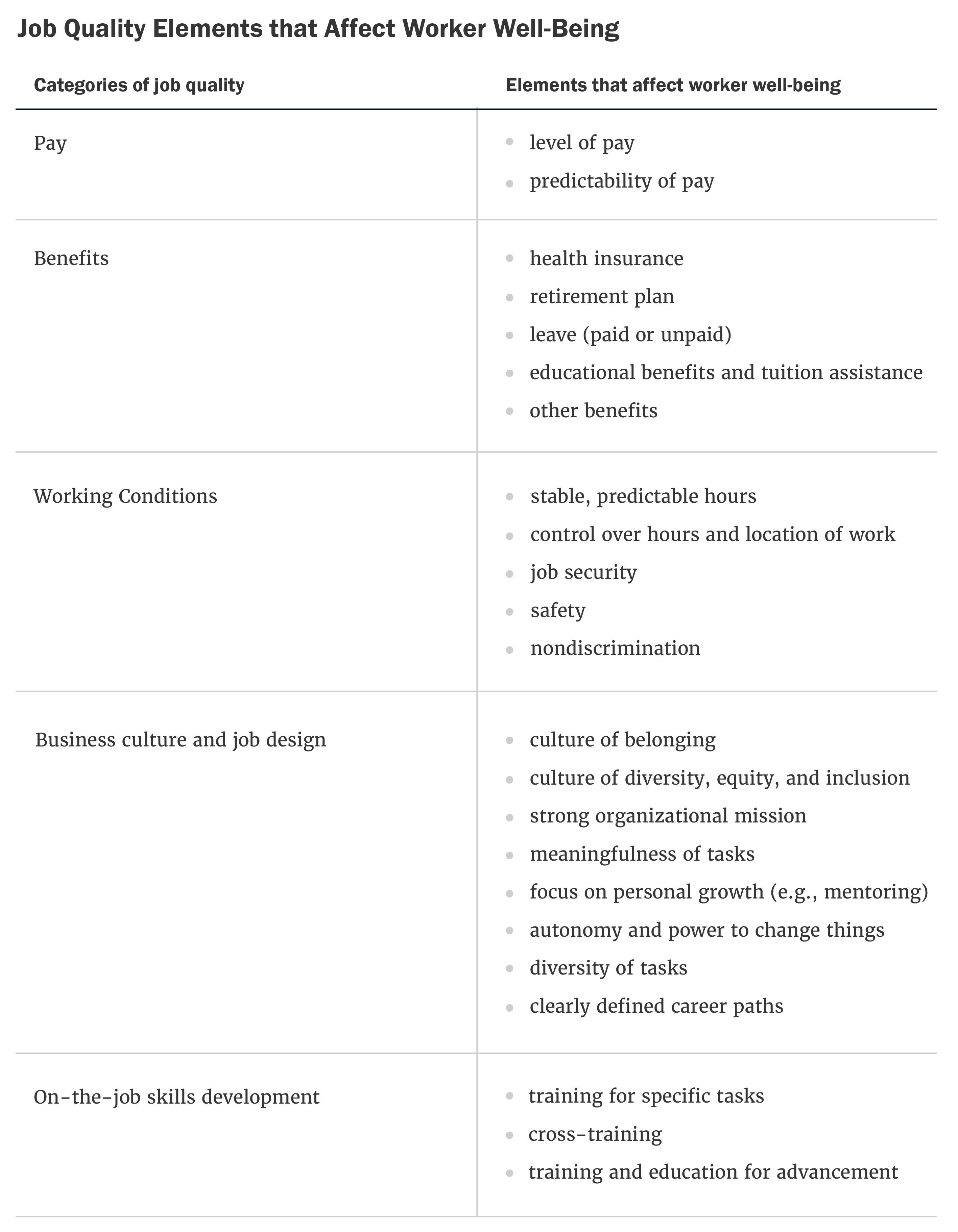This post is the first in a series devoted to exploring the elements of what makes a “good” or “quality” job and understanding the relationship between job quality and economic mobility, that is, their ability to advance and increase their earnings in the labor market. These posts elevate key insights from a new body of work from the Urban Institute that develops an agenda for research on how stakeholders including policymakers, employers, advocates, and practitioners can accelerate economic mobility among low-wage workers through elements of job quality. This post shares a new framework for defining good jobs; other posts explore evidence on job quality elements that facilitate economic mobility, taking a racial equity lens in improving access to good jobs, what workers value in jobs, and a new agenda for research on job quality and mobility. To learn more about this project, visit Building America’s Workforce.
The COVID-19 economic crisis has spotlighted inequities in pay, job protections, working conditions, and sick and paid leave benefits, giving urgency to the notion that more workers—particularly those in low-wage jobs and occupations—need access to quality jobs. We might instinctively know what a “good” or “quality” job is, but several definitions of job quality have emerged across different sectors and disciplines. Developing a common language or framework for stakeholders to use when talking about quality jobs and understanding how different job quality elements affect worker well-being are critical first steps toward creating these jobs.
Last year, our team embarked on a study to create a framework for discussing good jobs. We studied 11 prominent definitions of job quality (see links below) to understand how key stakeholders—business and industry, government, academia, and civil society groups—define good jobs. Although these definitions varied in scope and complexity, they also share common elements. Our framework classifies these elements into five broad categories: pay, benefits, working conditions, business culture and job design, and on-the-job skill development.
In our scan of the research literature, we found at least some empirical evidence that each of the following job-quality elements improves workers’ lives in some way, providing them with greater economic or financial security, better physical and mental health, or greater satisfaction with their work. The table below is adapted from one found in our report.

Notably, certain patterns emerged in our review: pay and working conditions appeared in all 11 definitions, nonwage benefits such as health insurance were included in 9 definitions, on-the-job training and business culture and job design had the fewest mentions with 5 and 4, respectively.
Evidence on how different job-quality elements affect worker well-being
In our scan of literature, we found that across the five job-quality categories, specific elements affect well-being outcomes in measurable and sometimes surprising ways. Here is a select group of findings (a more comprehensive list can be found in our report):
- Better wages lead to healthier workers. One study demonstrates a link between low earnings and higher mortality, and another shows higher wages are associated with improved physical health.
- Well-designed retirement plans increase retirement wealth.
- Paid family leave is associated with improved maternal mental health and better long-term outcomes for children.
- Unpredictable schedules are associated with psychological distress. Some workers are willing to accept jobs with reduced wages to avoid schedules set on short notice.
- Workers find jobs with greater autonomy to be more meaningful. Workers with autonomy in their jobs report higher levels of psychological well-being.
- Employer-provided training increases wages.
These job-quality elements don’t exist in a vacuum. After all, a job is not made up of a random collection of elements, but multiple elements reflecting a deliberate set of choices and practices and market realities. For example, it is no coincidence that jobs with low wages are often missing other elements the promote economic security, such as health insurance and retirement. Job-quality elements also can’t be evaluated independently from a workers’ preferences or the greater social and economic context in which people work.
Although the evidence base linking specific elements to specific measures of well-being is strong, more research is needed on how multiple elements within a job combine to affect well-being, whether workers require or and firms offer trade-offs between elements, and the effects of those trade-offs are. Another critically important outcome is what these job-quality elements mean for workers’ economic mobility. This question is at the heart of our project and will be explored in depth in the next post.
We consulted the following definitions in developing our framework:
Business and industry
Not Just a Job: New Evidence on the Quality of Work in the United States
Advancing Frontline Women and Advancing Frontline Employees of Color
Government
2019 Federal Employee Viewpoint Survey
Academia
Where Have All the Good Jobs Gone? (PDF)
Labor Market Segmentation and Union Wage Premium
Declining Job Quality in the United States: Explanations and Evidence
Private Sector Job Quality Index
Civil society/international
International Labour Organization's Decent Work Indicators